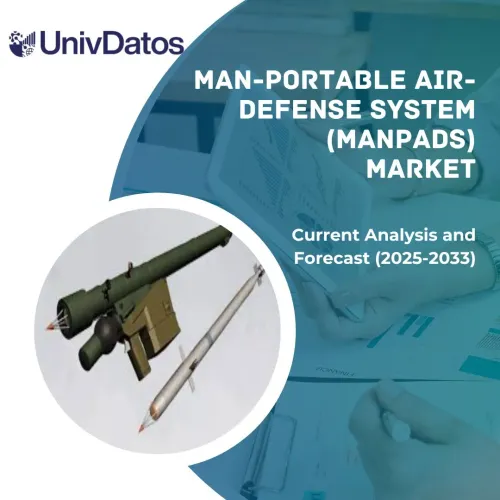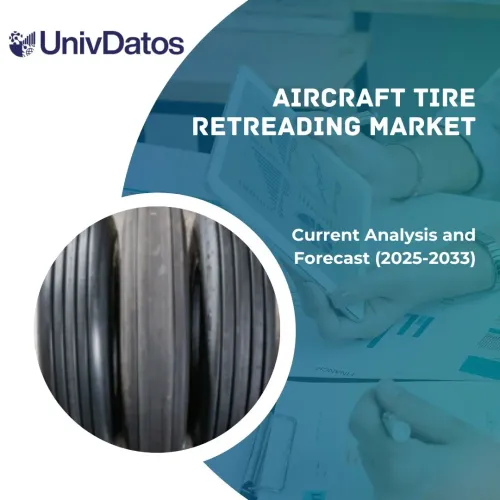- Strona główna
- O nas
- Branża
- Usługi
- Czytanie
- Kontakt
Rynek urządzeń do odladzania samolotów: Aktualna analiza i prognoza (2023-2030)
Nacisk na Typ Sprzętu (Pojazdy do Odladzania, Zamiatarki i Inne), Zastosowanie (Komercyjne i Wojskowe) oraz Region/Kraj
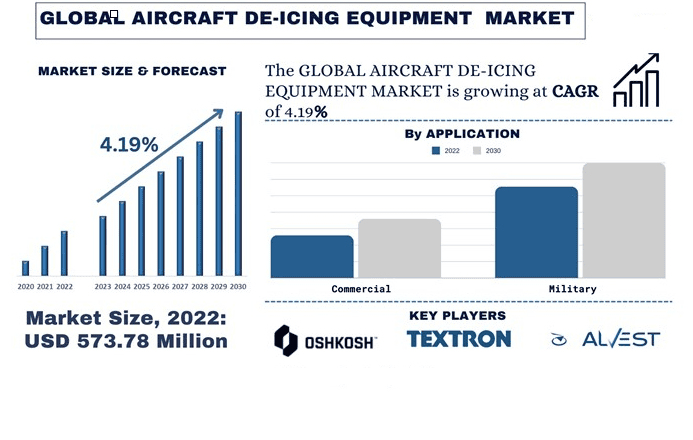
Wartość globalnego rynku sprzętu do odladzania samolotów wyniosła 573,78 mln USD w 2022 r. i oczekuje się, że w okresie prognozy (2023-2030) wzrośnie przy CAGR wynoszącym 4,19%. ze względu na wzrost ruchu lotniczego i rozwój przemysłu lotniczego.
Rynek sprzętu do odladzania samolotów – analiza
Nieustanny wzrost ruchu lotniczego jest jednym z najważniejszych czynników napędzających rynek sprzętu do odladzania samolotów. Międzynarodowe Stowarzyszenie Transportu Lotniczego (IATA) prognozuje, że globalna liczba pasażerów lotniczych przekroczy 4 miliardy w 2024 roku. Ten wzrost, szczególnie w regionach o surowej zimowej pogodzie, przekłada się na większy popyt na rozwiązania w zakresie sprzętu do odladzania, aby zagwarantować bezpieczne loty. Ponadto organy lotnicze na całym świecie stają się coraz bardziej rygorystyczne w zakresie przepisów bezpieczeństwa dotyczących oblodzenia i zanieczyszczenia śniegiem samolotów. Na przykład Federalna Administracja Lotnictwa (FAA) bezwzględnie nakazuje, aby samoloty nie startowały, nawet jeśli występują śladowe ilości szronu, śniegu lub lodu, ponieważ znacząco wpływa to na aerodynamikę i siłę nośną. Te rygorystyczne protokoły bezpieczeństwa sprawiają, że usługi związane ze sprzętem do odladzania są istotnym i bezdyskusyjnym aspektem działalności linii lotniczych, szczególnie w zimnym klimacie. Niedopełnienie tego obowiązku grozi poważnymi karami, opóźnieniami lotów, a nawet tragicznymi wypadkami. Dlatego lotniska i linie lotnicze intensywnie inwestują w wydajne technologie, płyny i infrastrukturę sprzętu do odladzania, co napędza wzrost rynku.
Do głównych graczy działających na rynku należą Oshkosh Corporation, Textron Inc. (Textron Specialized Vehicles), Kiitokori Oy, Alvest Group, Vestergaard Company, Global Ground Support, LLC., Aero Mag, LNT Solutions, Cavotec SA i TREPEL Airport Equipment GmbH. Gracze ci podejmują szereg fuzji i przejęć wraz z partnerstwami, aby ułatwić klientom korzystanie z zaawansowanych technologicznie i innowacyjnych produktów/technologii.
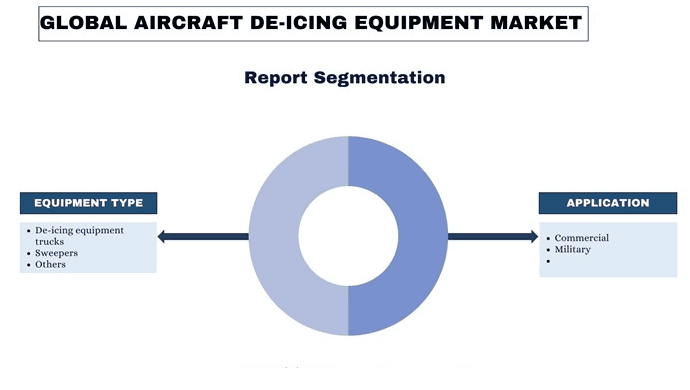
Trendy na rynku sprzętu do odladzania samolotów
„Wśród typów sprzętu, segment ciężarówek do odladzania ma znaczący udział w rynku w 2022 roku.”
Ze względu na typ sprzętu rynek jest podzielony na ciężarówki do odladzania, zamiatarki i inne kategorie. Sektor ciężarówek do odladzania był dominującą siłą na rynku w 2022 r. i przewiduje się, że utrzyma swoją pozycję lidera w nadchodzącym okresie prognozy. Ciężarówki do odladzania są zaprojektowane z dużymi zbiornikami na płyny, co umożliwia im transport znacznych ilości płynów do odladzania. Ta zwiększona pojemność minimalizuje konieczność częstego uzupełniania, co skutkuje zwiększoną wydajnością operacyjną i skróceniem czasu realizacji procedur odladzania. Ponadto ciężarówki do odladzania są wyposażone w funkcje i systemy bezpieczeństwa, które zapewniają bezpieczeństwo personelowi zaangażowanemu w proces odladzania.
Spośród zastosowań, segment komercyjny ma znaczący udział w rynku w 2022 roku.”
Ze względu na zastosowanie, rynek jest podzielony na segmenty komercyjny i wojskowy. W 2022 r. segment komercyjny ma znaczący udział w rynku i oczekuje się, że utrzyma ten trend w okresie prognozy. Do wzrostu tych segmentów przyczyniają się główne czynniki, takie jak rosnący ruch lotniczy i rosnąca sprzedaż floty komercyjnej na całym świecie. Ponadto surowe przepisy organów lotniczych dotyczące procedur odladzania samolotów skłoniły linie lotnicze do inwestowania w zaawansowane technologie i rozwiązania. Dodatkowo nacisk na bezpieczeństwo i komfort pasażerów skłonił linie lotnicze do skupienia się na wydajnych procesach sprzętu do odladzania, aby zapobiec opóźnieniom i odwołaniom spowodowanym trudnymi warunkami pogodowymi.
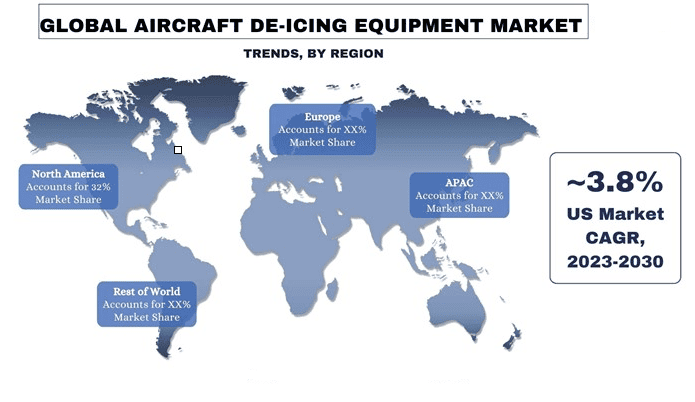
„Azja i Pacyfik zdominowały rynek sprzętu do odladzania samolotów w 2022 r.”
Rozległe obszary Azji i Pacyfiku obejmują różnorodne strefy klimatyczne. Kraje w regionach północnych, takie jak Japonia, Korea Południowa i części Chin, doświadczają surowych zim z obfitymi opadami śniegu i długimi okresami temperatur poniżej zera. Tymczasem obszary położone na dużych wysokościach w krajach takich jak Indie i Nepal są podatne na opady śniegu i mrozy, co stanowi wyzwanie dla operacji lotniskowych. Nieprzewidywalne wzorce pogodowe, takie jak nagłe fale zimna i marznący deszcz, mogą również wpływać na inne części regionu. Te zmienne warunki podkreślają znaczenie posiadania niezawodnego sprzętu do odladzania, który ma zapewnić płynne operacje lotnicze w sezonie zimowym. Azja i Pacyfik są kluczowym graczem w globalnym przemyśle podróży lotniczych, z jednymi z najbardziej ruchliwych lotnisk na świecie i znacznym wzrostem liczby tanich przewoźników, co sprawia, że podróże lotnicze są bardziej dostępne. Ten wzrost ruchu pasażerskiego bezpośrednio koreluje z wyższym popytem na usługi sprzętu do odladzania w chłodniejszych miesiącach. Obecnie trwają wysiłki w celu zbadania przyjaznych dla środowiska płynów do odladzania, takich jak te zawierające mrówczan potasu lub inne opcje biobazy, szczególnie na lotniskach zlokalizowanych w Japonii i Korei Południowej.
Raport dotyczący rynku sprzętu do odladzania samolotów – zakres
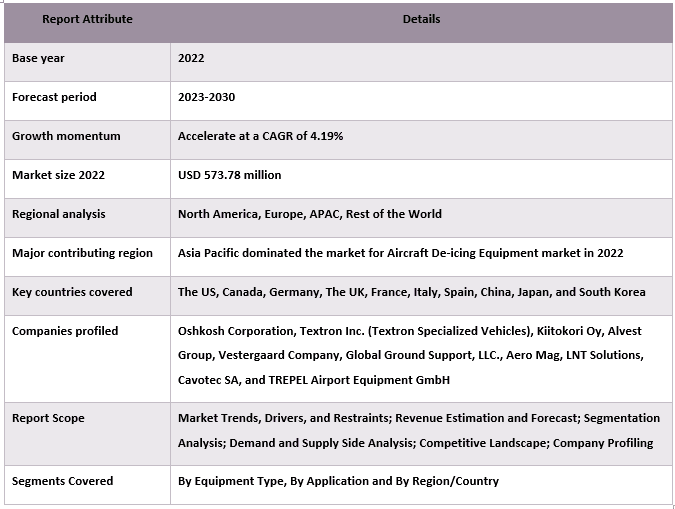
Powody, dla których warto kupić ten raport:
- Badanie obejmuje analizę wielkości rynku i prognozowania, zatwierdzoną przez uwierzytelnionych kluczowych ekspertów branżowych.
- Raport przedstawia szybki przegląd ogólnych wyników branży na pierwszy rzut oka.
- Raport obejmuje dogłębną analizę wybitnych firm z branży, z głównym naciskiem na kluczowe dane finansowe, portfele produktów, strategie ekspansji i najnowsze osiągnięcia.
- Szczegółowe badanie czynników napędzających, ograniczeń, kluczowych trendów i możliwości panujących w branży.
- Badanie kompleksowo obejmuje rynek w różnych segmentach.
- Dogłębna analiza branży na poziomie regionalnym.
Opcje dostosowywania:
Globalny rynek sprzętu do odladzania samolotów można dodatkowo dostosować zgodnie z wymaganiami lub dowolnym innym segmentem rynku. Poza tym UMI rozumie, że możesz mieć własne potrzeby biznesowe, dlatego zachęcamy do kontaktu z nami, aby otrzymać raport, który w pełni odpowiada Twoim wymaganiom.
Spis treści
Metodologia badań rynku urządzeń do odladzania samolotów (2023-2030)
Analiza historycznego rynku, szacowanie obecnego rynku i prognozowanie przyszłego rynku globalnego rynku urządzeń do odladzania samolotów to trzy główne kroki podjęte w celu stworzenia i przeanalizowania adopcji urządzeń do odladzania samolotów w głównych regionach na całym świecie. Przeprowadzono wyczerpujące badania wtórne, aby zebrać historyczne dane rynkowe i oszacować obecną wielkość rynku. Po drugie, aby zweryfikować te spostrzeżenia, wzięto pod uwagę liczne ustalenia i założenia. Ponadto przeprowadzono również wyczerpujące wywiady pierwotne z ekspertami branżowymi w całym łańcuchu wartości globalnego rynku urządzeń do odladzania samolotów. Po założeniu i walidacji danych rynkowych poprzez wywiady pierwotne zastosowaliśmy podejście odgórne/oddolne do prognozowania całkowitej wielkości rynku. Następnie przyjęto metody podziału rynku i triangulacji danych w celu oszacowania i analizy wielkości rynku segmentów i podsegmentów branży, do której należą. Szczegółowa metodologia została wyjaśniona poniżej:
Analiza historycznej wielkości rynku
Krok 1: Dogłębne badanie źródeł wtórnych:
Przeprowadzono szczegółowe badanie wtórne w celu uzyskania historycznej wielkości rynku urządzeń do odladzania samolotów za pośrednictwem wewnętrznych źródeł firmy, takich jak raporty roczne i sprawozdania finansowe, prezentacje wyników, komunikaty prasowe itp., oraz źródeł zewnętrznych, w tym czasopisma, wiadomości i artykuły, publikacje rządowe, publikacje konkurencji, raporty sektorowe, bazy danych stron trzecich i inne wiarygodne publikacje.
Krok 2: Segmentacja rynku:
Po uzyskaniu historycznej wielkości rynku urządzeń do odladzania samolotów przeprowadziliśmy szczegółową analizę wtórną w celu zebrania historycznych informacji rynkowych i udziałów dla różnych segmentów i podsegmentów dla głównych regionów. Główne segmenty zawarte w raporcie to typ sprzętu i zastosowanie. Przeprowadzono dalsze analizy na poziomie krajów w celu oceny ogólnego przyjęcia modeli testowania w danym regionie.
Krok 3: Analiza czynnikowa:
Po uzyskaniu historycznej wielkości rynku różnych segmentów i podsegmentów przeprowadziliśmy szczegółową analizę czynnikową w celu oszacowania obecnej wielkości rynku urządzeń do odladzania samolotów. Ponadto przeprowadziliśmy analizę czynnikową przy użyciu zmiennych zależnych i niezależnych, takich jak typ sprzętu i zastosowanie urządzeń do odladzania samolotów. Przeprowadzono dokładną analizę scenariuszy popytu i podaży, biorąc pod uwagę najważniejsze partnerstwa, fuzje i przejęcia, ekspansję biznesową i wprowadzenie produktów na rynek w sektorze urządzeń do odladzania samolotów na całym świecie.
Szacowanie obecnej wielkości rynku i prognoza
Określanie obecnej wielkości rynku: Na podstawie praktycznych spostrzeżeń z powyższych 3 kroków doszliśmy do obecnej wielkości rynku, kluczowych graczy na globalnym rynku urządzeń do odladzania samolotów i udziałów rynkowych segmentów. Wszystkie wymagane udziały procentowe i podziały rynku zostały określone przy użyciu wyżej wymienionego podejścia wtórnego i zostały zweryfikowane poprzez wywiady pierwotne.
Szacowanie i prognozowanie: Do szacowania rynku i prognozowania przypisano wagi różnym czynnikom, w tym czynnikom napędzającym i trendom, ograniczeniom i możliwościom dostępnym dla interesariuszy. Po przeanalizowaniu tych czynników zastosowano odpowiednie techniki prognozowania, tj. podejście odgórne/oddolne, aby dojść do prognozy rynkowej na rok 2030 dla różnych segmentów i podsegmentów na głównych rynkach na całym świecie. Metodologia badań przyjęta do oszacowania wielkości rynku obejmuje:
- Wielkość rynku branży, pod względem przychodów (USD) i stopa adopcji rynku urządzeń do odladzania samolotów na głównych rynkach krajowych.
- Wszystkie udziały procentowe, podziały i rozbicia segmentów i podsegmentów rynku.
- Kluczowi gracze na globalnym rynku urządzeń do odladzania samolotów pod względem oferowanych produktów. Ponadto strategie wzrostu przyjęte przez tych graczy, aby konkurować na szybko rozwijającym się rynku.
Walidacja wielkości i udziału w rynku
Badania pierwotne: Przeprowadzono dogłębne wywiady z kluczowymi liderami opinii (KOL), w tym z kadrą kierowniczą najwyższego szczebla (CXO/wiceprezesi, kierownik sprzedaży, kierownik marketingu, kierownik operacyjny, kierownik regionalny, kierownik krajowy itp.) w głównych regionach. Następnie podsumowano wyniki badań pierwotnych i przeprowadzono analizę statystyczną w celu udowodnienia postawionej hipotezy. Dane wejściowe z badań pierwotnych zostały skonsolidowane z ustaleniami wtórnymi, przekształcając w ten sposób informacje w praktyczne spostrzeżenia.
Podział uczestników badań pierwotnych w różnych regionach
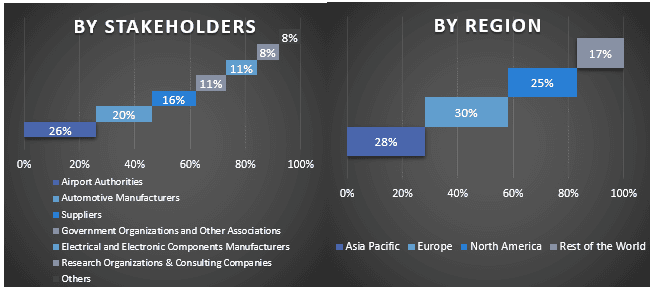
Inżynieria rynku
Zastosowano technikę triangulacji danych, aby zakończyć ogólne szacowanie rynku i dojść do precyzyjnych danych statystycznych dla każdego segmentu i podsegmentu globalnego rynku urządzeń do odladzania samolotów, dane zostały podzielone na kilka segmentów i podsegmentów po przestudiowaniu różnych parametrów i trendów w obszarach typów sprzętu i zastosowań na globalnym rynku urządzeń do odladzania samolotów.
Główny cel badania rynku urządzeń do odladzania samolotów
W badaniu określono obecne i przyszłe trendy rynkowe globalnego rynku urządzeń do odladzania samolotów. Inwestorzy mogą uzyskać strategiczne spostrzeżenia, aby oprzeć swoje decyzje inwestycyjne na analizie jakościowej i ilościowej przeprowadzonej w badaniu. Obecne i przyszłe trendy rynkowe określiły ogólną atrakcyjność rynku na poziomie regionalnym, zapewniając platformę dla uczestnika przemysłowego do wykorzystania niezbadanego rynku, aby czerpać korzyści z przewagi pioniera. Inne ilościowe cele badań obejmują:
- Analiza obecnej i prognozowanej wielkości rynku urządzeń do odladzania samolotów pod względem wartości (USD). Ponadto analiza obecnej i prognozowanej wielkości rynku różnych segmentów i podsegmentów.
- Segmenty w badaniu obejmują obszary typu sprzętu i zastosowania.
- Zdefiniowanie i analiza ram regulacyjnych dla urządzeń do odladzania samolotów
- Analiza łańcucha wartości związanego z obecnością różnych pośredników wraz z analizą zachowań klientów i konkurencji w branży.
- Analiza obecnej i prognozowanej wielkości rynku urządzeń do odladzania samolotów dla głównego regionu.
- Główne kraje regionów badane w raporcie to Azja i Pacyfik, Europa, Ameryka Północna i reszta świata
- Profil firmy zajmującej się urządzeniami do odladzania samolotów oraz strategie rozwoju przyjęte przez uczestników rynku w celu utrzymania się na szybko rozwijającym się rynku.
- Dogłębna analiza branży na poziomie regionalnym
Najczęściej zadawane pytania FAQ
P1: Jaka jest obecna wielkość rynku i potencjał wzrostu globalnego rynku urządzeń do odladzania samolotów?
P2: Jakie są czynniki napędzające wzrost globalnego rynku sprzętu do odladzania samolotów?
P3: Który segment ma największy udział w globalnym rynku urządzeń do odladzania samolotów pod względem rodzaju sprzętu?
P4: Jakie są wschodzące technologie i trendy na globalnym rynku urządzeń do odladzania samolotów?
P5: Który region zdominuje globalny rynek sprzętu do odladzania samolotów?
P6: Kim są kluczowi gracze działający na globalnym rynku urządzeń do odladzania samolotów?
Powiązane Raporty
Klienci, którzy kupili ten przedmiot, kupili również






